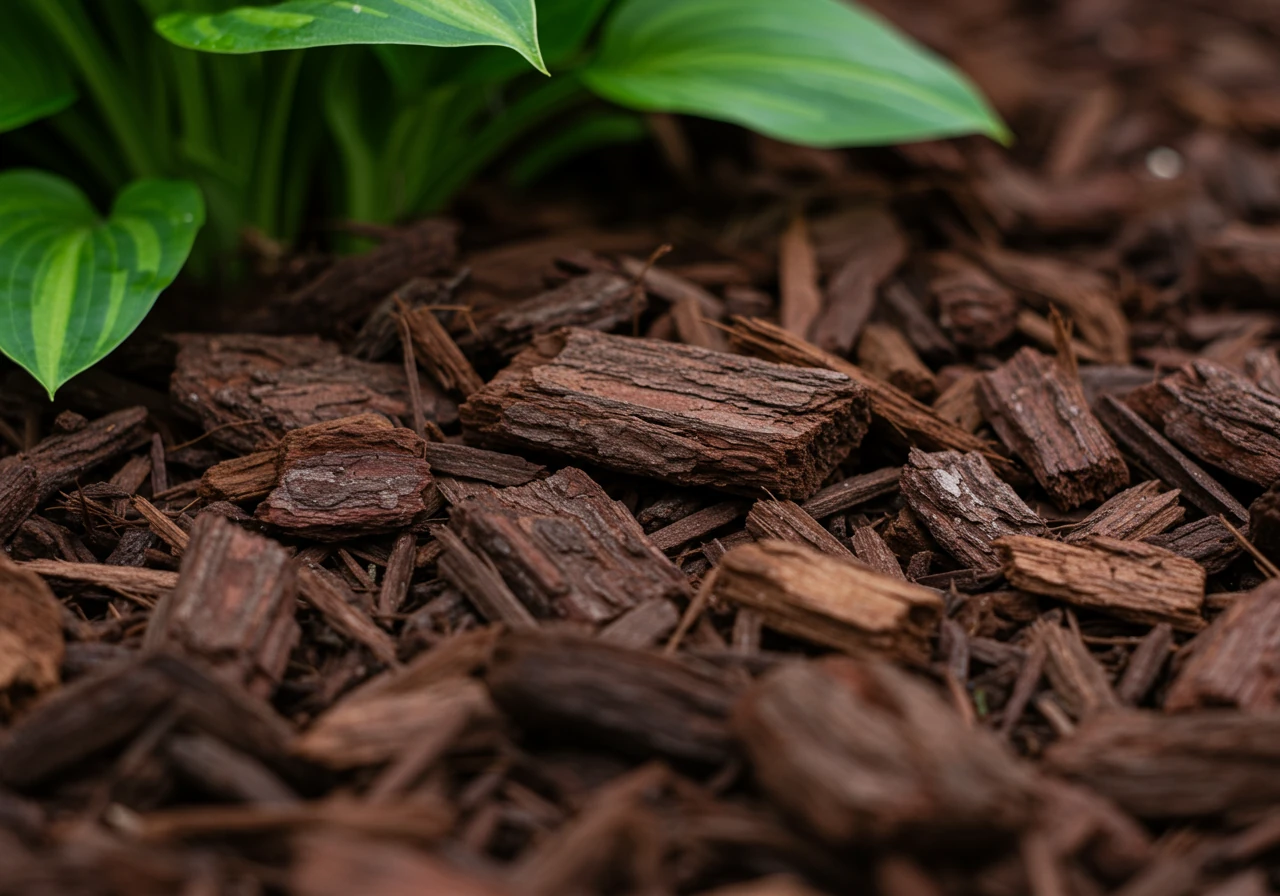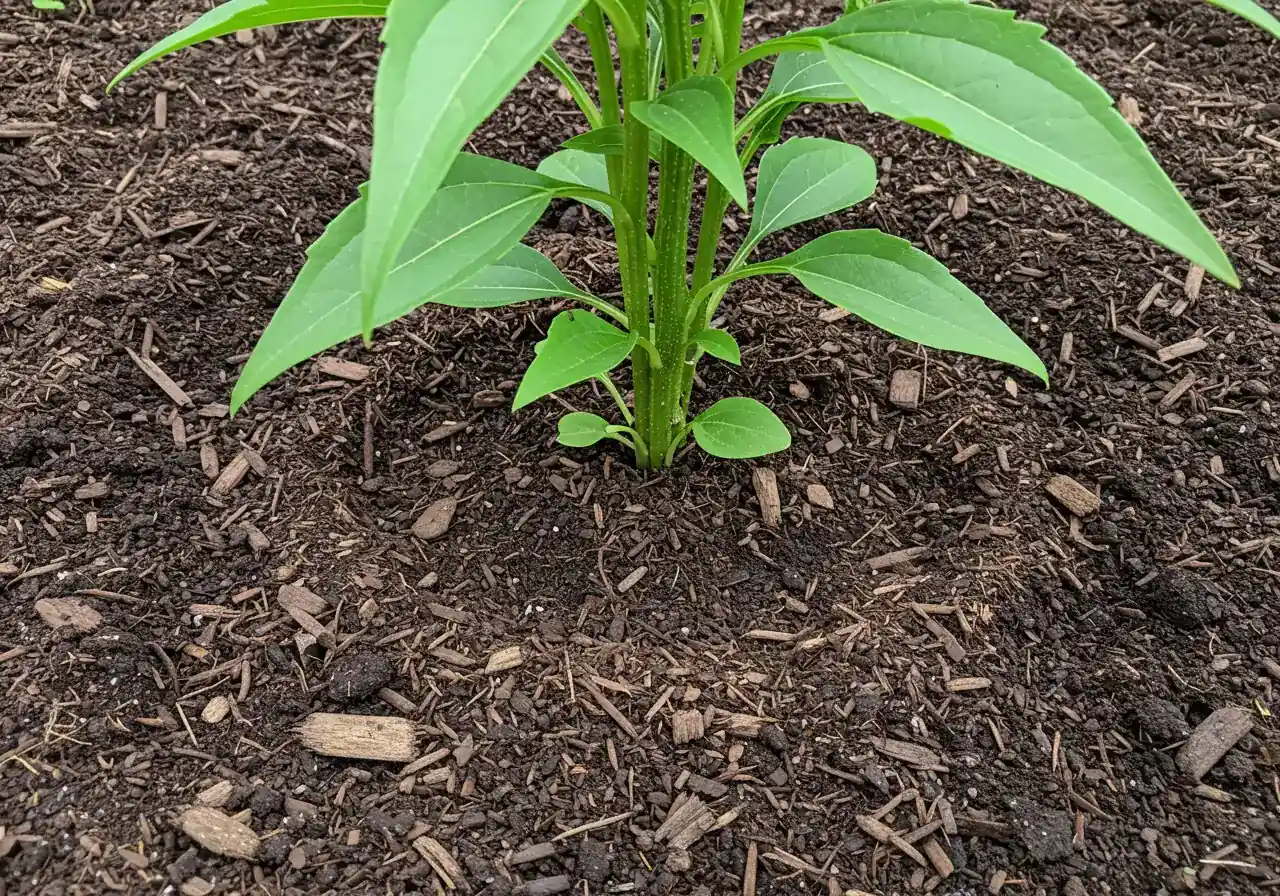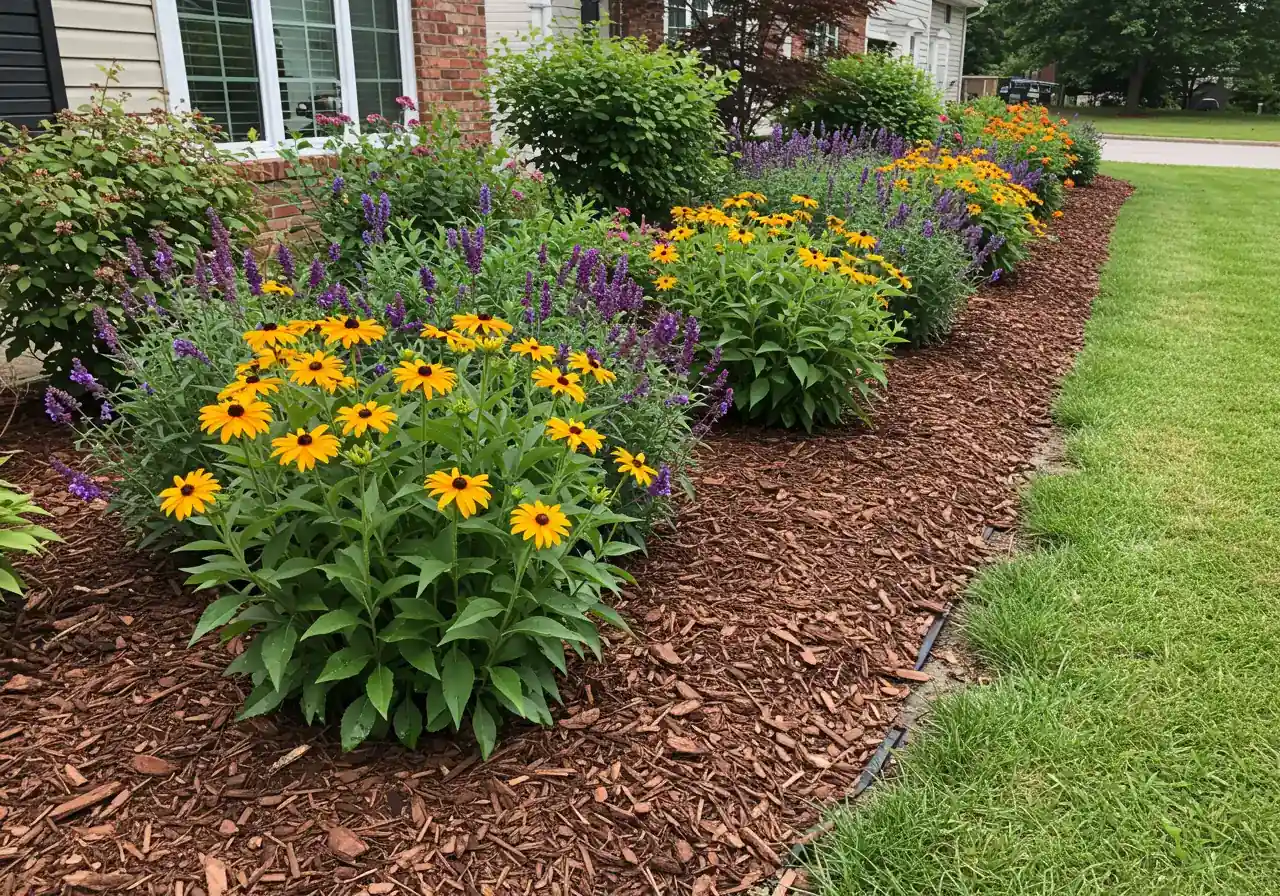Cool Greely Garden Roots: Summer Microclimate Mulch Tips
Quick Summary
- Microclimates in your Ottawa yard cause temperature/moisture variations.
- Mulch acts like a protective blanket: cooling roots, retaining moisture, suppressing weeds.
- Organic mulches (bark, compost) are best for improving soil.
- Apply 2-4 inches deep, avoiding direct contact with plant stems ('mulch donut').
- Mulch offers year-round benefits, not just summer cooling.
Need help getting your garden beds perfectly mulched? Request your quote today!
Intro: Beating the Heat in Greely (and Your Garden!)
Ah, Ottawa summers! One minute we're complaining about the frost, the next our poor plants look like they need an ice-cold lemonade even more than we do. Ever notice how one corner of your garden seems to bake while another stays surprisingly cool? You're seeing microclimates in action right in your own backyard! These mini weather zones mean some plants struggle more than others under the summer sun.
But don't sweat it! There's a fantastic landscaping tool that’s a real game-changer, especially for keeping gardens happy in areas like Greely or even Manotick where sunny spots abound. The superhero of summer gardening? Mulch! Think of it as a protective blanket for your soil – it helps keep roots cool, locks in moisture (meaning less watering for you!), and even keeps pesky weeds down.
In this section, we’ll explore how this simple addition can make a huge difference in beating the heat and keeping your garden thriving all season long. Let's dig in!
Why Your Ottawa Garden Gets Hot Under the Collar: Understanding Local Microclimates

Question: So, what's the big deal with Ottawa summers? My garden seems fine sometimes and struggles other times.
Answer: You've hit the nail on the head! Ottawa summers are a bit of a rollercoaster for our gardens. We get blessed with lovely heat and sunshine, perfect for barbecues, but sometimes too perfect. That heat, often paired with sticky humidity, can really stress plants out. Plus, our rainfall can be unpredictable – sometimes we get drowned, other times it's drier than a forgotten cracker. Add to that the common soil types in many areas, like the heavy clay soil found in parts of Greely or Nepean. Clay soil holds water tightly when wet but can bake hard and crack when dry, making life tough for plant roots trying to breathe and find moisture. If you're dealing with tough soil, learning about Greely sod installation in clay soil is a good start for lawns.
Question: I keep hearing the term "microclimate." Is that like tiny weather?
Answer: Pretty much! Think of your yard not as one big weather zone, but a patchwork quilt of mini-zones. That's a microclimate. It’s the specific climate conditions in a small, localized area – like your garden, or even just part of your garden. For example, the soil right next to a south-facing brick wall will be much hotter and drier than the soil under a large maple tree just a few steps away. A low spot might stay damp longer after rain, while a windy corner dries out fast. Even different neighbourhoods have subtle variations – a garden in breezy Manotick might face different drying winds than one tucked away in a more sheltered part of Barrhaven. Understanding these zones helps you choose the right plants for the right spot. It’s also why planning ahead, like considering spring tree planting strategies even in Greely clay soil, can pay off by creating future shade.
Question: Why is managing the soil temperature and moisture so important? Can't plants just tough it out?
Answer: Well, some are tougher than others, but roots are sensitive souls! When soil gets too hot, roots struggle to function properly. They can’t absorb water and nutrients efficiently, even if they're available. This leads to stressed, wilted, and unhappy plants – think of it as trying to run a marathon wearing a winter coat in July! Conversely, soil that's constantly waterlogged suffocates roots. Stressed plants are also way more likely to get sick, which is why keeping things tidy and using clean tools is vital; you can learn more about how to keep Greely garden tools sharp and clean to prevent disease. Keeping the root zone cool and consistently moist (but not soggy!) is key for healthy growth. Techniques like mulching help moderate temperature, while practices like aeration can improve drainage and air circulation in compacted soils – definitely check out the secrets of Greely fall lawn aeration for healthier soil. For professional soil care, consider our soil preparation services.
Question: How can I figure out the microclimates in my own yard?
Answer: Become a garden detective! Spend time observing.
- Notice where the sun hits hardest and for how long throughout the day.
- Check where snow melts first in spring (usually warmer spots).
- See where puddles linger after rain (damper, cooler spots).
- Feel the soil temperature in different areas on a hot day.
- Notice where certain plants thrive and others struggle.
Keeping your yard clear helps too; sometimes overgrown areas or debris can affect these mini-zones. If things feel overwhelming, getting a professional Greely yard cleanup service can give you a clean slate to observe from. Understanding these unique spots is the first step to making smarter planting and care decisions, and if you need broader help, exploring various professional landscaping services can provide tailored solutions. You can even find us on Google for local reviews and info!
Mulch Ado About Something: Choosing Your Champion Cooler

Alright, garden warriors, we've established that mulch is like sunscreen and a cool drink for your soil. But walk into any garden centre, and the choices can feel overwhelming! Shredded bark? Pretty pebbles? What's the difference, and which one will be the ultimate champion cooler for your Ottawa garden? Fear not, choosing the right mulch isn't rocket science, but knowing your options helps you pick a winner. Let's break down the main contenders: organic vs. inorganic using this handy tab interface.
Organic Mulches: The Soil Superheroes
These mulches come from living (or once-living) things and are generally fantastic for improving your soil over time. They break down, adding nutrients and organic matter – basically, feeding your soil while they protect it.
- Shredded Bark/Wood Chips: The classic choice! Comes in various sizes and colours (cedar, pine, hemlock).
- Pros: Looks natural, suppresses weeds well, retains moisture, decomposes slowly adding organic matter. Cedar mulch can also help deter some insects. Widely available and often seen in established gardens from Osgoode to Barrhaven.
- Cons: Needs replenishing every few years as it breaks down. Can sometimes slightly acidify soil (usually not a major issue). Make sure it's sourced well – you don't want diseased wood. Consider professional mulching and edging for perfect application.
- Pine Needles (Pine Straw): Lighter and airier than bark.
- Pros: Great for acid-loving plants (like blueberries, rhododendrons), decomposes slowly, allows water and air to penetrate easily, looks attractive and unique.
- Cons: Can be blown around in windy spots, less common to find commercially in Ottawa. Best harvested from your own (or a neighbour's!) pine trees after a good cleanup.
- Compost/Leaf Mould: Dark, rich, and full of goodness. Often used as a top dressing or a thinner mulch layer.
- Pros: Excellent soil conditioner, adds lots of nutrients, fantastic eco-friendly choice (especially if homemade!). Great for vegetable gardens. Consistent garden maintenance often involves adding compost.
- Cons: Breaks down quickly so needs frequent reapplication as a primary mulch. May contain weed seeds if not fully composted ('hot' composting kills most seeds). Our Ottawa garden clean up service can help prepare beds.
- Straw: Best known for vegetable gardens.
- Pros: Cheap, excellent moisture retention and temperature moderation, suppresses weeds well, decomposes adding organic matter.
- Cons: Can contain weed or grain seeds, might attract slugs or rodents, looks less formal than bark chips for flower beds.
Inorganic Mulches: The Long-Lasting Protectors
These materials don't break down, meaning they last much longer. However, they don't improve your soil structure or fertility.
- Stone/Gravel/Pebbles: Offers a neat, modern, or even desert-like look.
- Pros: Very long-lasting (permanent!), excellent weed suppression (especially over landscape fabric), low maintenance. Can look sharp in specific landscape designs.
- Cons: *Doesn't improve soil*. Can absorb and *radiate* heat, potentially overheating plant roots in full sun – not always the "cooler" champion! Can be difficult to plant in later. Heavy and harder to remove if you change your mind. If you're facing a garden overwhelmed by old gravel mulch, you might need a thorough Marionville property cleanup service to start fresh.
- Landscape Fabric: Often used *under* other mulches (organic or inorganic).
- Pros: Excellent weed barrier initially.
- Cons: Can prevent organic matter from reaching the soil, hinders air and water exchange over time, weeds can eventually grow *on top* of it, plastic fabrics aren't eco-friendly and break down into microplastics. Often requires a major property clean up to remove effectively once it degrades.
- Rubber Mulch: Made from recycled tires.
- Pros: Long-lasting, bouncy (good for play areas), excellent weed suppression.
- Cons: Doesn't improve soil, concerns about chemicals leaching into the soil/water, can get very hot, potential fire hazard, not a natural look, not easily removed. Definitely not our top eco-friendly pick for gardens. Check our terms and conditions regarding materials we handle.
Making Your Choice: The Best Bet for Ottawa
So, which mulch reigns supreme? For most Ottawa gardens, especially flower beds and around trees and shrubs, organic mulches like shredded bark or compost are the best all-around choice. They protect, cool, conserve water, AND feed your soil. Preparing your beds properly before applying mulch is key – clear out weeds and debris first. If the task seems daunting, consider help from an Ottawa city garden clean up service to get a clean slate.
For vegetable gardens, compost or clean straw often work wonders. Even addressing weeds beforehand, perhaps with targeted support like a Marionville garden clean up service if needed, makes your mulch far more effective. Stone can work for specific, low-maintenance areas away from intense heat, but use it thoughtfully.
Remember, a healthy garden starts with healthy soil, and organic mulches are your best partners in building that foundation. Before you even spread your mulch, ensure the garden bed is clear of unwanted debris or overgrown plants; sometimes a professional touch like a Greely yard cleanup service makes all the difference in prepping the area perfectly. Need help with material selection? We can assist!
Choose wisely, apply generously (usually 2-4 inches deep, keeping it away from direct contact with plant stems), and watch your garden thrive!
Getting Your Mulch On: Application Tips for a Cool Greely Summer

Okay, so you're convinced. Mulch is the cool kid on the block (literally, for your soil!) and you're ready to roll up your sleeves. But hold your horses (or wheelbarrows)! Applying mulch isn't just about dumping it down; there's a bit of an art to it to get those maximum cooling benefits for your garden, especially during those potentially scorching Greely summer days. Let’s get mulching the right way!
When's the Best Time to Mulch?
Ideally, apply mulch in mid-to-late spring. Why then? The soil has had a chance to warm up a bit after the winter thaw, but it’s before the real Ottawa summer heat kicks in and dries everything out. You want to lock in that lovely spring moisture! Applying too early can keep the soil too cool and damp. If you missed the spring window, early summer is still beneficial, especially after a good rain. Consider external resources like the City of Ottawa's gardening page for seasonal tips.
Step 1: Prep Like a Pro
Before you even think about opening that bag of mulch, prep work is crucial. Don't skip this – it makes all the difference!
- Weed Ruthlessly: Pull out every single weed you can find in the garden bed. Mulch helps prevent new weeds, but it won't magically kill established ones. They’ll just push right through. Get those roots! This is essential whether you're in a leafy Nepean neighbourhood or dealing with Greely's specific weed challenges. Our Marionville yard cleanup service can tackle tough weeding jobs.
- Tidy Up: Remove any dead leaves, fallen branches, or other debris. You want the mulch directly on the soil (or maybe over a thin layer of compost).
- Edge It: Create a clean edge around your garden beds using an edger or spade. This gives a sharp, professional look and helps keep your mulch in the bed and off your lawn.
- Check Your Soil: Is it compacted? Aerating beforehand can help. Is it lacking nutrients? Adding a layer of compost before mulching is a great idea. Good soil preparation is the foundation for everything else.
- Water Wisely: If the soil is bone dry, give it a good watering before applying mulch. You want to trap moisture in*, not keep it *out*.
Feeling overwhelmed by the prep work? Getting your garden beds ready can be a big job, especially if things have gotten a bit wild. Sometimes calling in the experts for an initial clear-out, like an Metcalf yard cleanup service, can save you time and hassle, setting you up perfectly for mulching success.
Step 2: Apply with Care
Now for the main event!
- Spread Evenly: Use a rake or your hands (gloves recommended!) to spread the mulch evenly over the soil surface. Don't just dump piles.
- Depth Matters: Aim for a depth of about 2 to 4 inches (5-10 cm). Too thin, and it won't do a good job suppressing weeds or retaining moisture. Too thick, and you risk suffocating your soil and plant roots by blocking air and water flow. Different materials might require slightly different depths, which is where considering your mulch material selection carefully comes in handy.
- The Crucial Donut! This is super important. Do not pile mulch directly against the stems of your plants or the trunks of trees. This is often called a "mulch volcano" and it's a big no-no! Piling mulch against stems traps moisture, invites pests and diseases like rot, and can essentially suffocate the plant. Instead, create a "donut" shape – leave a few inches of bare space around the base of each plant stem or tree trunk. Let them breathe!
Step 3: Finishing Touch
- Water Again (Lightly): Once the mulch is down, give it a light watering. This helps settle the mulch into place and gets the moisture retention process started.
Common Mulching Mistakes to Avoid:
- Mulch Volcanoes: Piling mulch against plant stems. Always leave space!
- Too Thick or Too Thin: Aim for the 2-4 inch sweet spot.
- Mulching Bone-Dry Soil: Water the soil first if needed.
- Skipping the Weeding: Existing weeds will push through. Remove them first. If weeds are out of control, our Ottawa property cleanup service can help reset the area.
Applying mulch correctly is a fantastic investment in your garden's health and beauty. It keeps things cool, reduces your watering chores, and makes your plants happier campers during the summer heat. You'll be amazed at the difference it makes – check out some potential garden transformations that often include smart mulching! Happy mulching, and here’s to a cool, thriving Greely garden! And hey, thank you for taking the time to learn how to mulch like a pro!
More Than Just a Summer Fling: Year-Round Mulch Magic in the Ottawa Valley
Think mulch is just a summer superhero for keeping gardens cool in Greely? Think again! While it's brilliant at battling the summer heat, mulch is actually a four-season friend to your garden beds right here in the Ottawa Valley. It works hard all year long, tackling the unique challenges our climate throws its way – from frosty winters to muddy springs.
Fall Benefits
Acts like a blanket, insulating roots against early frosts. Prevents soil compaction from heavy rains. Makes leaf cleanup slightly easier. Prep beds with a good cleanup via our Metcalfe property cleanup service before winter.
Winter Protection
Crucial insulation against freeze-thaw cycles, preventing plant heaving. Protects crowns and roots from severe cold damage, vital after a new garden installation. Helps reduce soil erosion from wind and snowmelt.
Spring Advantages
Helps prevent soil crusting as snow melts, allowing water penetration. Suppresses early spring weeds. Maintains good soil structure established by proper soil preparation. A city yard cleanup service can clear winter debris first.
Summer Cooling
Reduces water evaporation from soil, conserving moisture. Keeps plant roots cooler under direct sun. Continues to suppress weeds, reducing competition for resources. Essential for gardens across the valley.
Remember, while mulch is fantastic for garden beds, it's not a substitute for proper lawn care – grass has its own specific needs! Applying mulch consistently is a simple, effective way to support your garden's health throughout Ottawa's distinct seasons. As a professional service focused on your property's well-being, we also prioritize transparency in all our operations; you can always review Our Privacy Policy on our website. For local conservation tips, check the Rideau Valley Conservation Authority.
Mulch Effectiveness Boost (Illustrative)
*Illustrative percentage increase in effectiveness with proper mulching techniques vs. bare soil.
Hot Tips for Cool Roots: Quick Wins
So, you’ve embraced the marvellous magic of mulch! High five! Your garden beds are looking sharp, and you know you’re doing your plants a huge favour, especially with Ottawa's summer sun doing its best to bake everything. But wait, there's more! Like tuning up a car for peak performance, there are a few extra tricks to make sure your mulch is working overtime to keep those roots cool and happy all summer long. Let’s dive into some quick wins to really maximize those benefits.
Your Quick Wins Cheat Sheet:
- Depth Check: Peek under the mulch mid-summer; top up if needed to keep that 2-4 inch layer consistent for insulation.
- Water Wisely: Ensure water soaks through* the mulch to the soil below; check soil moisture, not just the mulch surface. Regular checks are part of good city garden maintenance service.
- Fluff It Up: Gently rake compacted mulch surfaces to improve water penetration and airflow if water runs off. This small effort complements larger tasks like Ottawa sod installation projects.
- Weed Patrol: Pull any sneaky weeds that pop through *before they get big and steal resources. Easier than a major city property cleanup service later!
- Mind the Gaps: Keep mulch pulled back from plant stems ("donut" rule!) and maintain clean edges. If things get messy, a Metcalfe garden clean up service can restore order.
Making these small tweaks ensures your plants stay cool, hydrated, and happy, even when the Ottawa summer brings the heat! Got more questions or need a hand keeping your garden in top shape? Don't hesitate to contact us for landscaping advice or provide estimate feedback.
Greely & Ottawa Mulch FAQs: Your Questions Answered!
You've got questions about mulch, and we've got answers! Mulching seems simple, but doing it right makes a world of difference for your garden's health and your curb appeal, especially around Greely and the wider Ottawa area. Let's tackle some common queries using these collapsible sections.
Organic mulches like shredded bark or wood chips are your best friends here! As they break down, they add valuable organic matter, gradually improving that sticky clay structure. This means better drainage and aeration for healthier roots. Proper application matters too; our expert mulching and edging techniques ensure mulch helps, rather than hinders, your soil in places like Nepean or Greely.
Yes, depth definitely matters! Aim for a consistent layer of 2 to 4 inches (5-10 cm). Too thin, and weeds laugh while moisture escapes. Too thick (like a mulch volcano!), and you risk blocking essential air and water from reaching the soil and roots. Getting that Goldilocks depth – just right – is key for happy plants.
Generally, no. Most common garden mulch isn't a primary food source for termites, who prefer wood in contact with soil. Keeping mulch a few inches away from your foundation is crucial pest prevention advice. Overall property tidiness discourages pests; ensuring gutters are clear and debris is removed via a regular Ottawa yard cleanup service helps immensely too!
We usually recommend skipping the landscape fabric, especially under organic mulches. While it blocks weeds short-term, it prevents the mulch from improving your soil and can eventually hinder water/air movement. Plus, removing old, degraded fabric later can be a real chore, sometimes needing a professional Ottawa property cleanup service to sort out the mess. You can find more resources from local groups like the Friends of the Central Experimental Farm.
Great observation! Organic mulch naturally decomposes over time, feeding your soil (which is good!). Plan to check its depth each spring. If it's looking thin (under 2 inches) or you see soil peeking through and weeds emerging, it’s time for a top-up to maintain benefits. Long-term garden vitality is our goal; learn more about us and our commitment to sustainable garden care.
Oh, we wish it were that easy! Unfortunately, mulching over existing weeds (especially persistent ones) is rarely effective – they'll likely just push right through. Proper bed preparation, including thorough weeding, is essential first. If your beds in areas like Metcalfe are feeling overwhelming, our dedicated Metcalfe garden clean up service crew can whip them into shape before mulching.
Conclusion: Keep Your Cool and Let Your Greely Garden Thrive!

Well, there you have it! Who knew a simple layer of mulch could be such a gardening superstar, especially right here in our sunny (and sometimes surprisingly chilly) Ottawa region? From keeping your soil cool and moist during those Greely summer scorchers to protecting precious plant roots from winter's wrath, mulch truly is a year-round garden buddy. It helps beat back weeds, saves you watering time, and even improves your soil over time – talk about a multi-tasker!
Remember the key takeaways: choose the right mulch for your needs (usually organic goodies like bark), prepare your beds properly by weeding first, apply it to that sweet spot depth of 2-4 inches, and always give your plants breathing room by avoiding those dreaded mulch volcanoes around the stems. A little effort goes a long way in creating a happier, healthier garden landscape, whether you're in Greely, over in Manotick, or anywhere across the Valley. Need help with larger scale cleanups? Check out our City Garden Maintenance Service.
Feeling inspired but maybe a bit overwhelmed by the wheelbarrow? Let us handle the heavy lifting! Ready to give your garden the ultimate cool-down treatment? Contact Clean Yards today for expert mulching and landscaping services! We'll get your beds looking sharp and your plants thriving.
Want more tips for a beautiful Ottawa yard? Check out resources from the Master Gardeners of Ottawa-Carleton. Keep cool, keep gardening, and enjoy your thriving outdoor space!

